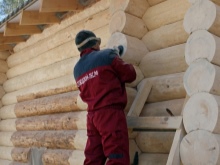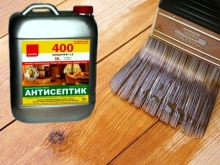How and with what to bleach wood?

Over time or as a result of improper transportation, the wood may darken or become moldy. The only way to cope with this without damaging the material is to bleach it with folk or industrial means.



What is it for?
Bleaching wood helps to deal with several major problems.
- The effects of fungus on wood. Mold negatively affects the texture of the wood. Therefore, after the fungus has been removed, it is necessary to restore the texture and color of the wood damaged by mold.
- Natural aging. Over time, the tree loses its external luxury, and by lightening it, you can return things to their former attractiveness. But here it is important to remember that when working with a tree that has darkened from time to time, you can whiten only its upper layers, and a darker undertone will shine through the layer.
- Influence of intense sunlight, temperature changes and precipitation. This is more true for structures that are outside the home.
- Traces of exposure to paint and other chemicals. If the wood has been painted, and then cleaned of paint, its natural appearance can be restored in this way.
Wood is also bleached in order to increase its durability and protect it from the appearance of mold in the future.



How can you whiten?
For whitening, you can use industrial facilities, but you can do it a solution prepared at home.
Folk remedies
To whiten blackened surfaces and refresh their appearance, you can use lime milk. This is the most popular option for those new to woodworking.
To prepare it, 10 g of baking soda are mixed with 80 g of bleach. All this is filled with water. You need to take 350 ml of warm water. The resulting whitening product should brew well. To do this, he must be sent to a dark place for two days. After that, it should be used immediately, because if it stands a little longer, it will lose its effectiveness.
You can also use a product based on hydrogen peroxide. Here it is necessary to observe the following proportions: 40% peroxide solution plus 30% ammonia solution in a ratio of 9 to 1. The more saturated the solution is, the more noticeable the result will be. The bleach should be infused. This takes about 12 hours. After that, you can start working.
It is worth remembering that peroxide is not suitable for all materials. For example, it does not bleach beech, but dyes it. It is worth using a peroxide solution when bleaching walnut or birch.


Industrial compounds
If there is no trust in folk remedies, you can purchase a finished product. There are several types of industrial bleaches.
- Chlorine-free... They are completely safe and have no corrosive effect on wood. Once fully saturated, they are very easy to wash off. Chlorine-free bleaches can be used multiple times on the same surface. They have no negative impact on the material. They are best used for bleaching wood that has acquired a slight yellow color or darkened with age.
- Chlorine products... These products are more aggressive and are used to solve serious problems. For example, to restore wood after exposure to mold. The disadvantage of such products is that they have a pungent and unpleasant odor. In addition, they are much more difficult to wash off.It is also important to follow the instructions so as not to damage the tree.
- Oxalic acid products. They are used to remove rust marks from wood. Such products work effectively, but at the same time they do not "kill" the natural color of the tree.

If we talk about specific brands, you should pay attention to a few of the most popular ones.
- "White"... Periodically, "Whiteness" is used to bleach wood. This is one of the most budget-friendly ways to deal with darkened wood. It is important to work with gloves and not to allow the product to come in contact with the skin or eyes.
- Neomid 500. This product is used for cleaning wood from various stains and traces of mold or for bleaching the material. It perfectly removes unpleasant gray deposits and helps to restore the wood to its natural color. It does not destroy its structure. You can use the liquid for processing old furniture, pallets, which are used for storing food and other wood products.
- "Sagus". Bleaches from this brand are used for quick and, importantly, deep coloring. Wood takes on a natural look even if it is quite old or has been exposed to mold. The product also has a protective effect on the material. After processing, mold, fungi and moss do not appear on the wood.
- Fongifluid. This popular product is more professional. The tool allows you to cope with even the most difficult problems. The product is good because it does not contain toxic substances and is completely safe both for the tree and for the health of those who work with it. It also acts as an antiseptic, protecting wood.



Stages of work
To return the tree to its natural color or give it whiteness, you should do everything right, without skipping any of the stages of the work.
Before getting down to business, you have to choose the perfect moment. It is best to bleach wood at home at a temperature of about 20 degrees. Humidity at this time should not be too high either. It is in this situation that the product will most effectively penetrate the structure of the material, and the master will achieve the desired effect.
It is best to work with wood during the warmer months. If outdoor buildings are painted, then in winter and autumn this does not make much sense. The fact is that in the cold season, mold ceases to be active. It stops growing. Myceliums are activated already at the end of April.
Indoors, wood is at risk at any time of the year. Especially in high humidity and high temperature environments. Therefore, surfaces can be processed at any suitable time.


Having chosen the time, you need to prepare all the necessary materials and tools.
- Product preparation... If an industrial product is used, then you just need to follow the instructions for use. In the case of homemade solutions, they are usually prepared in advance, and then allowed to brew.
- Surface treatment... Before you rid the boards or any other wood materials from blackness, you must first clean the surface from fungus, roughness and dry well. If the product is not entirely made of wood, then the aluminum and glass surfaces must be protected from the ingress of even the smallest amount of bleach. After that, a thin layer of the product is applied to the tree. In order not to harm yourself, be sure to carry out all work in protective gloves.
The first layer should dry well. After that, you need to evaluate the result. If it is not good enough, you need to repeat the procedure again. Then the excess bleach should be removed and the wood should be left alone overnight.


Here are some additional guidelines for those planning to paint a log with their own hands.
- If an acid-based product was used, then wash it off with a high-quality soda solution. Other bleaches are easily washed off with water.
- To lighten wood, you can use only one product and do not mix several bleaches.
- In case the material has been affected by mold, the bleaching composition should be more concentrated.
- If a glued product is being processed, then it is not worth trying to lighten it with any bleaching product, because the wood can come unstuck.
- When processing wood inside the house, it is very important that the room in which the work takes place is well ventilated.
- Often the walls and other furniture in the sauna are wooden. Due to high humidity and high temperatures, mold and mildew often develop there. When lightening the wood in these rooms, after processing the material, you need to heat the bath in order to consolidate the result.
Any wood can be processed in this way. The main thing is to take into account its features. So, oak boards and beech must be treated with a product with a lower concentration of the main active element.


Preventive measures
In order for the tree to retain its attractiveness longer, it is very important to carry out preventive actions... They help protect wood from microorganisms. Dry wood should be covered with antiseptics. So it will definitely not rot and become stained. After treatment with an antiseptic, the material must be dried.
Whatever the reason for the change in the color of the wood, you can cope with this problem, moreover, in several ways at once. The main thing is to follow all the rules specified in the instructions.



For information on how to bleach wood, see the next video.













The comment was sent successfully.